- About us»
- Net income calculator»
- Population aging»
-
- Least developed regions»
-
- Average wage
- Material need benefits
- Meal allowance
- Counties of Slovakia
- Inflation
- Living and Subsistence Minimum
- Unemployment of Czechia and Slovakia
- NACE Classification
-
- Life expectancy
- Gender differences
- Youth unemployment and NEET
- Minimum wage in EU
- Unemployment rates of different age groups
- Share of salaries on GDP
- Employment rate
- Percentage of employees ususally working at nights
- NEET
- Long term unemployment
- Unemployment rate
-
- Bratislava and surroundings
- Kopanice
- Danube river
- lower Vah river
- middle Vár river
- upper Nitra river
- lower Nitra river
- Mining cities
- Kysuce a Orava
- upper Vah river - Liptov
- Spiš cities
- upper Hron river
- Juhoslovenská kotlina
- Košice fold and Torysa river
- upper Zemplín
- lower Zemplín
- EU regions
- NUTS3 regions of Slovakia
- LAU1 dataset
-
- Projects and activities
- Inclusive growth»
- Good work
- Project SKRS
- Social system – reality and vision
-
- Education of unemployed
- Young unemployed not taking part in education
- Proposal to change the system of education funding
- Library
- News»
- Contact
Hesse – DE7
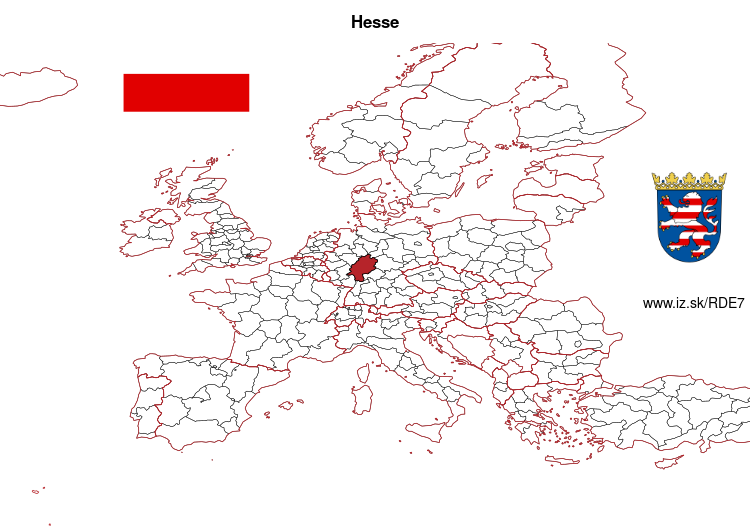
| Indicator | Period | Value |
|---|---|---|
| Life long learning | ||
| life long learning participation | 2024 | 10 |
| Part time jobs and flexible employment | ||
| percentage of part time workers | 2024 | 30.65 |
| percentage of part time workers, men | 2024 | 13.16 |
| percentage of part time workers, women | 2024 | 50.49 |
| Gender differences | ||
| gender gap in employment rate | 2024 | 90.27 |
| gender gap in unemployment rate | 2024 | 85.29 |
| Graduates and young people | ||
| unemployment rate of youth with elementary education | 2024 | 9.8 |
| NEET | 2024 | 8.6 |
| Gross domestic product | ||
| GDP per capita in PPS of EU average | 2023 | 131 |
| Employment | ||
| employment rate | 2024 | 76.3 |
More on wikipedia wikidata Q1199 on OpenStreetMap Hesse slovensky: DE7
Subregions: Darmstadt Government Region, Giessen Government Region, Kassel Government Region
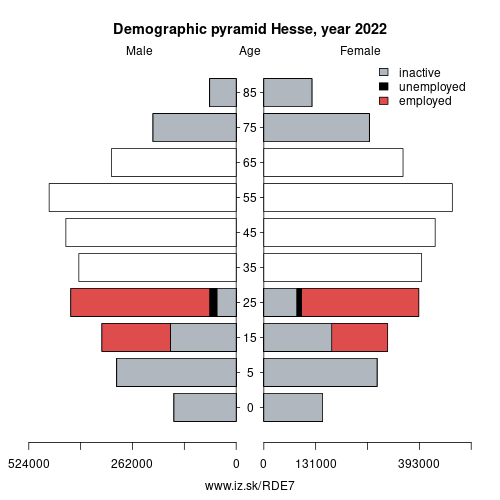
Unemployment
| Indicator | Period | Value |
|---|---|---|
| Unemployment | ||
| unemployment rate | 2024 | 3.3 |
| youth unemployment rate | 2024 | 6.5 |
| Long term unemployment | ||
| long term unemployment | 2024 | 0.9 |
| share of long term unemployed | 2024 | 27.1 |
Demographics
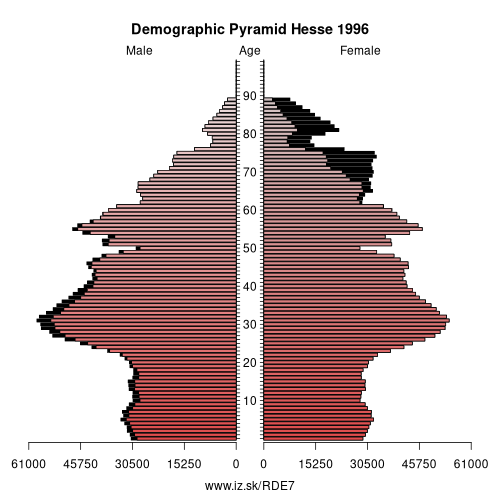
| Indicator | Period | Value |
|---|---|---|
| Demographics | ||
| number of inhabitants | 2024 | 6 267 546 |
| population density | 2023 | 297.2 |
| old-age dependency ratio | 2024 | 33.2 |
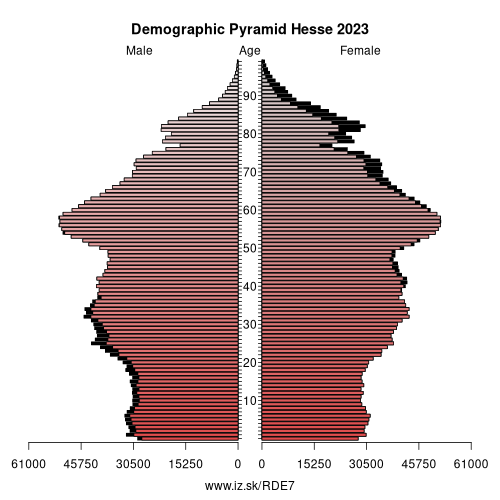
Employment by sectors, Hesse
| NACE r2 | % | NACE r2 | % | ||
|---|---|---|---|---|---|
| A | 21 | 1% | B-E | 548.4 | 17% |
| F | 204.3 | 6% | G-I | 724.1 | 23% |
| J | 131.5 | 4% | K | 161.4 | 5% |
| L | 34 | 1% | M_N | 343.5 | 11% |
| O-Q | 884.4 | 28% | R-U | 151.4 | 5% |
| TOTAL | 3203.9 | 100% |
Data for the period year 2024. Source of the data is Eurostat, table [lfst_r_lfe2en2].
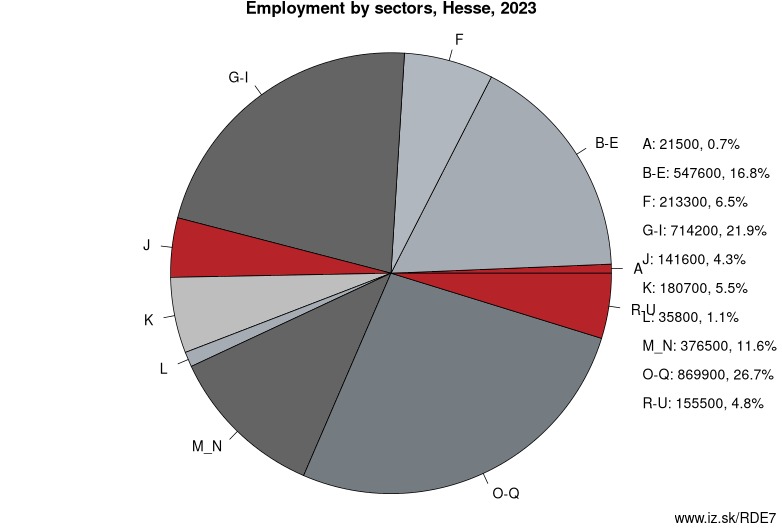
From Wikipedia: Hesse (, also US: , Hessian dialect: [ˈhɛzə]) or Hessia (UK: , US: ; German: Hessen [ˈhɛsn̩] (listen)), officially the State of Hesse (German: Land Hessen), is a federal state (Land) of the Federal Republic of Germany, with just over six million inhabitants. Its state capital is Wiesbaden and the largest city is Frankfurt am Main.
As a cultural region, Hesse also includes the area known as Rhenish Hesse (Rheinhessen) in the neighbouring state of Rhineland-Palatinate.
Name
The German name Hessen, like the name of other German regions (Schwaben „Swabia“, Franken „Franconia“, Bayern „Bavaria“, Sachsen „Saxony") is derived from the dative plural form of the name of the inhabitants or eponymous tribe, the Hessians (Hessen, singular Hesse), short for the older compound name Hessenland ("land of the Hessians"). The Old High German form of the name is recorded as Hessun (dative plural of Hessi), in Middle Latin as Hassia, Hessia, Hassonia. The name of the Hessians ultimately continues the tribal name of the Chatti.
The ancient name Chatti by the 7th century is recorded as Chassi, and from the 8th century as Hassi or Hessi.An inhabitant of Hesse is called a "Hessian" (German: Hesse (masculine) or Hessin (feminine), plural Hessen).
The American English term Hessian for 18th-century British auxiliary troops originates with Landgrave Frederick II of Hesse-Cassel hiring out regular army units to the government of Great Britain to fight in the American Revolutionary War.The English form Hesse is in common use by the 18th century, first in the hyphenated names Hesse-Cassel and Hesse-Darmstadt, but the latinate form Hessia remains in common English usage well into the 19th century.
The German term Hessen is used by the European Commission even in English-language contexts because their policy is to leave regional names untranslated (paragraphs 1.31 and 1.35).The synthetic element hassium, number 108 on the periodic table, was named after the state of Hesse in 1997, following a proposal of 1992.
History
The territory of Hesse was delineated only in 1945, as Greater Hesse, under American occupation. It corresponds only loosely to the medieval Landgraviate of Hesse.
Other: Germany, Saarland, Saxony, Saxony-Anhalt, Baden-Württemberg, Hamburg, Berlin, North Rhine-Westphalia, Hesse, Bavaria, Mecklenburg-Vorpommern, Schleswig-Holstein, Brandenburg, Bremen, Rhineland-Palatinate, Thuringia, Lower Saxony
Neighbours: Lower Saxony, Baden-Württemberg, North Rhine-Westphalia, Thuringia, Bavaria, Rhineland-Palatinate
Subregions: Darmstadt Government Region, Giessen Government Region, Kassel Government Region
Suggested citation: Michal Páleník: Europe and its regions in numbers - Hesse – DE7, IZ Bratislava, retrieved from: https://www.iz.sk/PDE7, ISBN: 978-80-970204-9-1, DOI:10.5281/zenodo.10200164

 Share
Share Facebook
Facebook Twitter
Twitter News
News